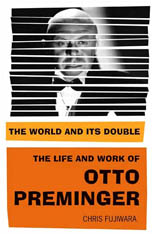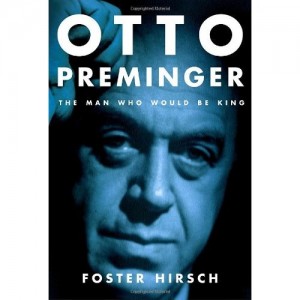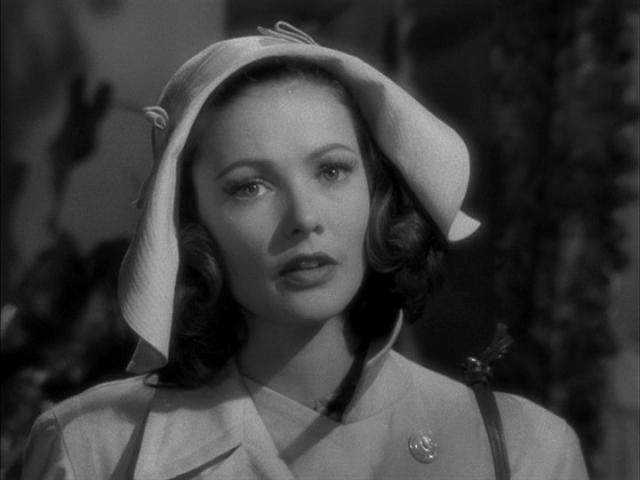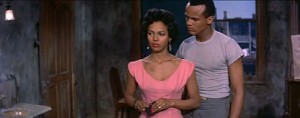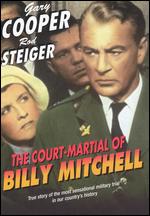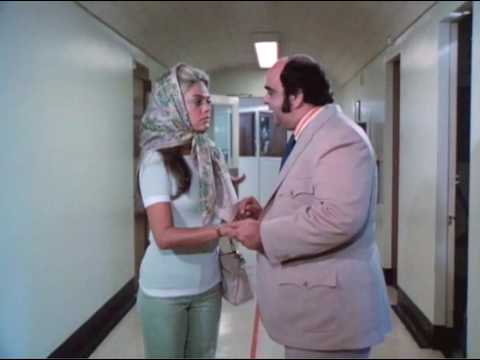From Cineaste, Summer 2008 (Vol. XXXIII, No. 3). It’s gratifying that Such Good Friends has finally come out on DVD. — J.R.
The World and its Double: The Life and Work of Otto Preminger
by Chris Fujiwara. New York: Faber & Faber, 479 pp., illus. Hardcover: $35.00.
Otto Preminger: The Man Who Would Be King
by Foster Hirsch. New York: Alfred A, Knopf, 573 pp., illus. Hardcover: $35.00
Few film directors resist critical biography as much as Otto Preminger, given all the puzzling and intractable mismatches one encounters as soon as one tries to reconcile his very public life with his no less private body of work as an auteur. This is a difficulty acknowledged in the title and subtitle of Chris Fujiwara’s book, and one he essentially tries to resolve by splitting most of his chapters into two sections. But the overall disassociation of Preminger’s life and work, even though it’s addressed by this structure, still becomes a kind of structuring absence that haunts this biography as well as Foster Hirsch’s, which tries to integrate the two concerns more conventionally. Both books are well worth having and major contributions to what we know about Preminger — substantially surpassing former efforts (which admittedly isn’t hard to do, given the thinness of the books by Willi Frishauer, Gerald Pratley, and Preminger himself), and all the more welcome given how neglected and misunderstood Preminger continues to be as an auteur. Yet a persistent feeling of uncertainty hangs over both studies. The degree to which Preminger’s mise en scene functioned as a private form of meditation which his public persona never acknowledged — an expression of curiosity about people that never achieves any satisfying closure, even when his plots pretend to find resolutions — continues to hang over his work like a perpetual question mark.
Arguably the same sort of discrepancy between life and work exists in the view of Alfred Hitchcock. But in that case the construction of an artificial public persona seems far more transparent. Ever since the French “discovery” of Hitchcock as a serious artist was conceded more universally, there hasn’t been a comparable problem in processing his work as art (as opposed to “mere” entertainment). By contrast, Preminger’s less artificial public persona as actor and director has continued to block our understanding of his work as an artist because any sense of an artistic design was even less evident in his public statements, which tended to focus on subject matter and avoided all questions of artistic intent.
To say that Preminger had a dual nature sounds like a truism, but dual natures are at the heart of his work, and many of the most pertinent features of his long-take style are methods of finding and revealing them. When I watched him shoot portions of Rosebud, possibly his worst film, one morning in Paris during the mid-70s, I could witness both his legendary temper tantrums during work and his graceful skills as a urbane host over lunch afterwards. Yet I also could see thoughtfulness shown to some employees at work as well as certain kinds of playful sadism shown to his lunch guests (at least to those he already knew—-I was lucky to find myself disqualified), such as teasing one of his best and most sympathetic French critics about his encroaching baldness.
The usual way of trying to make sense of this contradiction is to claim that either the sadism or the social grace was an “act,” but I came away convinced that both forms of behavior were theatrical “acts” as well as authentic — and if “authentic acting” is an oxymoron, Preminger’s work and personality seemed united by the persistence of that seeming contradiction. (On the other hand, his liberal sympathies, like his crusades against censorship, remained pretty consistent. A month or so later, when I was picketing in London as a British Film Institute employee on strike and Preminger was editing Rosebud next door, I successfully collared him to sign our petition.)
As drastically uneven in his output as Manoel de Oliveira — who otherwise resembles Preminger only in the unusual degree of aristocratic privilege that formed his family background — Preminger made a decisive leap from studio assignments to his own independent productions roughly halfway through his forty-odd years of directing American pictures. But his best films can’t be limited to either phase. My own ten current favorites are Laura, Fallen Angel, Whirlpool, Where the Sidewalk Ends, and Angel Face from the first period and Carmen Jones, The Man with the Golden Arm, Anatomy of a Murder, Bunny Lake is Missing, and Such Good Friends from the second. But even such a neat division disqualifies two creditable reversions to studio assignments after Preminger became an independent, The Court-Martial of Billy Mitchell and River of No Return.
Angel Face and Anatomy of a Murder, Preminger’s two supreme masterworks of sustained and balanced ambiguity, couldn’t be more disparate in the ways they were arrived at — a frantic retooling of an unwanted studio assignment and a carefully prepared and calibrated pet project — though the fact that each movie culminates in a trial is surely pertinent to what solicits Preminger’s involvement. (Much has rightly been made of Preminger being the son of Austria’s equivalent to what Americans call an attorney general.) Yet however one slices it, one can’t associate Preminger’s artistic identity chiefly with either phase of his career, and it’s fortunate that neither Hirsch nor Fujiwara ever comes close to attempting such a squeeze.
Where these two writers seem to differ most strikingly is in their critical sensibilities and methodologies. Hirsch gives us much more material about both Preminger’s Viennese upbringing and the responses of reviewers to his Hollywood features, and the former proves to be far more helpful than the latter: one can even intuit some boredom in the way Hirsch routinely tries to come up with fresh verbs (“sniffed,” “huffed,” “groused,”) to describe critical disapproval in reviews, inadvertently raising the question of whether we really need to know the opinions of journalists, most of them hacks, about each picture. And Hirsch’s own opinions, even though they’re relatively authoritative when it comes to assessing performances, often sound superfluous when they aren’t backed up by arguments. The fact that I disagree with him that Ace in the Hole is “smug”, that Samuel Fuller had a “hair-trigger temper” like Preminger’s, that Preminger “should have passed on directing” The Court–Martial of Billy Mitchell, or that The Man With the Golden Arm is his “only overrated film”, Bunny Lake is Missing is his “last fully assured work” (especially if one maintains that the unearned assurance of Hurry Sundown, made just afterwards, is the worst thing about it), and that Tell Me That You Love Me, Junie Moon is his only film “without a single redeeming feature” is all less important than the fact that Hirsch doesn’t even try to say much about these positions that might persuade me otherwise; ex cathedra judgments tend to predominate.
Fujiwara, by contrast, tends to show more intellectual and analytical curiosity about Preminger’s films, including the ones that don’t work for him — which makes for livelier critical prose, even though this seldom rises to the level of his definitive Jacques Tourneur: The Cinema of Nightfall — while Hirsch is often better with the biographical stretches, giving us a clearer view of Preminger’s public life. Both authors are rightly dismissive of Margin for Error (1943) — a dated and clumsy piece of period junk that wasn’t even saved by Preminger secretly hiring Fuller (on leave from war service) to rewrite it —- but Fujiwara characteristically manages to glean some meaning out of Preminger’s dehumanized direction. This was a play that Preminger previously directed on stage, and it’s unfortunate but understandable that neither writer can give us much sense of the theater work. (Preminger’s short-lived and disastrous stint of directing live television gets a couple of pages in both biographies, and Fujiwara intriguingly theorizes that this failure “suggests…that there was a basic gap between Preminger’s conception of theater and his conception of cinema, a gap that he made no effort to bridge and which may even have been the precondition for his success in both forms.”)
My main disappointment with both books is basically a matter of taste about what gets emphasized and privileged. I think both writers tend to overvalue the middlebrow monoliths of Preminger’s middle period such as Exodus and The Cardinal (which Hirsch calls “a square, ponderous, magnificent” film) while underestimating the fascinating singularity of three late curiosities — Skidoo, Tell Me That You Love Me,Junie Moon, and Such Good Friends. Without claiming that either of the first two of the latter trio are “successful”, I’d still argue that all three throw into bold relief Preminger’s hyperbolic illustration of democratic principles in action, and that in Such Good Friends — which oddly harks back to Laura in the way it skewers the heartlessness of New York sophistication — he created his final masterpiece.
In Skidoo, where Preminger enlists a huge assembly of movie and TV icons — Frankie Avalon, Carol Channing, Fred Clark (in his final screen performance), Jackie Gleason, Peter Lawford, Groucho Marx, George Raft. Cesar Romero, Mickey Rooney, Arnold Stang — he drastically undercuts their iconic qualities to show them as real people, with results that are plainly too peculiar and off-putting to qualify as comedy in the usual sense but are none the less forms of generous and amused appreciation more than simple denigration or cynicism. (The fact that Preminger took an LSD trip before making Skidoo is surely relevant to this radical kind of acceptance, as well as the gaudy colors and the even gaudier stylistic clashes.) But even after Fujiwara offers a very detailed production history, he seems stumped by the film’s themes and attitudes, which he sees mainly in negative terms — “a clash of empty signs”.
Writing off the anomalies in Skidoo and its two successors as “bad taste” — epitomized by Burgess Meredith as a famous author in Such Good Friends holding forth and then dancing nude at a rooftop party when the bemused Julie Messinger (Dyan Cannon) imagines him that way (for Fujiwara, “one of the film’s obvious lapses”), or, in the same movie, her husband’s doctor (James Coco) trying with embarrassment to secretly remove his girdle while Cannon prepares to give him a blow job — is far too easy and mechanical an escape hatch. This ultimately amounts to a puritanical rejection of Preminger’s radical humanism and its undeniable challenge to our cultural reflexes. Hirsch, who bravely and plausibly describes Cannon’s performance (along with Dorothy Dandridge’s in Carmen Jones) as the “finest work by an actress in any Otto Preminger film,” also complains that the latter sequence “cruelly and for no thematic purpose exposes [Coco’s] overweight torso”. But surely this character’s acute embarrassment about being overweight is central to the combined pathos, grotesquerie, and hysteria of this scene’s very black comedy — and Preminger counterpointing it with Julie’s own desperation, having just learned that her dying husband has been cheating on her with countless women, couldn’t be more thematically apposite. Indeed, Coco’s character — treated mercilessly in most of the picture for his hypocrisy and callousness —- is far more sympathetic here than anywhere else. (I’m grateful, by the way, for Fujiwara’s clarification that Elaine May is credited pseudonymously for her corrosively brilliant script not because of anything Preminger did to alter it — a common misperception — but only because she didn’t initiate the project, although she was understandably miffed about him blowing her cover afterwards.)
Insofar as Preminger’s interrogatory work resists closure, it’s perhaps inevitable that any comprehensive book about him is bound to be somewhat unsatisfying, at least as a summation. But it’s very much to the credit of both authors that their own curiosity about the man sustain their tireless investigations, making both of their books lively page-turners.

